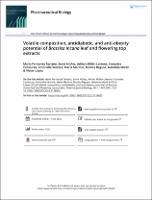Por favor, use este identificador para citar o enlazar este ítem:
https://repositorio.usj.es/handle/123456789/1056
| Título : | Volatile composition, antidiabetic, and anti-obesity potential of Brassica incana leaf and flowering top extracts |
| Autor: | López Ramos, Víctor


Taviano, Maria Fernanda 

Núñez Alonso, Sonia 
Millán-Laleona, Adrián 
Condurso, Concetta 
Verzera, Antonella 
Merlino, Maria 
Ragusa, Monica 
Miceli, Natalizia 


|
| Fecha de publicación: | 20-sep-2022 |
| Editorial : | Taylor & Francis |
| Citación : | Maria Fernanda Taviano, Sonia Núñez, Adrián Millán-Laleona, Concetta Condurso, Antonella Verzera, Maria Merlino, Monica Ragusa, Natalizia Miceli & Víctor López (2022) Volatile composition, antidiabetic, and anti-obesity potential of Brassica incana leaf and flowering top extracts, Pharmaceutical Biology, 60:1, 1994-2001, DOI: 10.1080/13880209.2022.2128825 |
| Resumen : | Context: Brassica incana Ten. (Brassicaceae) is an edible plant with very limited available information. Previous studies have demonstrated the polyphenolic profile and the antioxidant and cytotoxic properties of the leaf and flowering top hydroalcoholic extracts. Objective: The volatile composition and the antidiabetic and anti-obesity potential of B. incana leaf and flowering top extracts have been investigated. Material and methods: The volatile characterization of the extracts was attained by HS-SPME-GC/MS analysis. The antidiabetic and anti-obesity potential was investigated spectrophotometrically in vitro by the ability to modulate pancreatic lipase and a-glucosidase at different concentrations using orlistat and acarbose as reference drugs. The inhibition of advanced glycation end-products (AGEs) was measured with aminoguanidine as reference and the antioxidant activity with the xanthine/xanthine oxidase system and Trolox for comparative purposes. Results: Several volatiles belonging to different chemical classes were identified, being sulphur compounds the most abundant in both leaf and flowering top extracts (56.33% and 64.40% of all volatiles). Although the leaf extract showed lower IC50 values in most of the assays (0.968 and 1.921 mg/mL for a-glucosidase; 0.192 and 0.262mg/mL for AGEs; 0.022 and 0.038 mg/mL for superoxide scavenging), there were no statistically significant differences between both samples. These extracts showed a similar behaviour to Trolox in the xanthine oxidase assay (IC50 values of 0.022 mg/mL for leaf extract; 0.038 mg/mL for flowering top and 0.028 for Trolox). Conclusions: Leaves and flowering tops from B. incana can be used as sources of functional compounds that could act as antidiabetic and anti-obesogenic agents. |
| URI : | https://repositorio.usj.es/handle/123456789/1056 |
| Aparece en las colecciones: | Artículos de revistas |
Ficheros en este ítem:
| Fichero | Descripción | Tamaño | Formato | |
|---|---|---|---|---|
| Volatile composition antidiabetic and anti-obesity potential of Brassica incana leaf and flowering top extracts.pdf | 2,1 MB | Adobe PDF |  Visualizar/Abrir |
Este ítem está sujeto a una licencia Creative Commons Licencia Creative Commons

